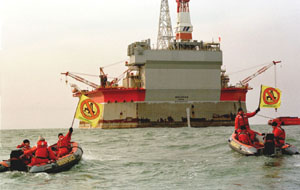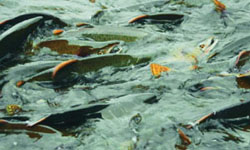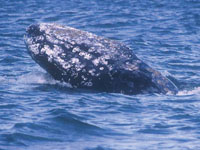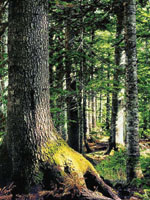Sakhalin's Environmental Quandaries
Back to Contents of Issue: July 2003
|
|
|
|
by David Wolman |
|
 WITH EVERYONE AND THEIR cousin racing to Sakhalin to build oil rigs, pipelines and roads in what was once untouched wilderness, environmental protection has become a major concern in this corner of the north Pacific. The Sakhalin oil and gas fields are close to some of the most active faults on the planet, and the Japanese maritime protection forces in nearby Hokkaido have already begun running drills in case of an oil spill. WITH EVERYONE AND THEIR cousin racing to Sakhalin to build oil rigs, pipelines and roads in what was once untouched wilderness, environmental protection has become a major concern in this corner of the north Pacific. The Sakhalin oil and gas fields are close to some of the most active faults on the planet, and the Japanese maritime protection forces in nearby Hokkaido have already begun running drills in case of an oil spill.
In September 2002, the Wall Street Journal ran a cover story comparing oil companies' environmental practices in Sakhalin with their practices in Alaska, stating examples in which foreign firms working in Russia were not doing everything they could or should when it came to protecting endangered Pacific gray whales, properly disposing of a drilling byproduct known as drilling muds or conserving fragile salmon habitats. Exxon and Sakhalin Energy thought it was a hatchet job.
"The claim that we're doing things here that we don't do in Alaska is simply not true," says Sakhalin Energy's spokesman Julian Barnes. Pointing to a USAID-commissioned report that refutes the claims of environmental groups, Barnes and Sakhalin Energy vehemently deny claims made in the Journal article.
Environmentalists are in a Assessing the possible effects of Sakhalin oil development on endangered Pacific gray whales is difficult. The relevant scientific research is sparse and what is available seems to verify claims on either side, depending who you ask. What is clear is that there are only an estimated 100 of these whales left in the world, and that fact alone puts environmentalists in a panic and oil companies on the defensive, even before anyone bothers to examine data about whale migration and eating patterns.
Environmentalists also accuse Sakhalin Energy of dragging its feet for years over its continued dumping of drilling muds and cuttings. In an October 2002 meeting with members of Sakhalin Environment Watch and Oakland, California-based Pacific Environment, the company pledged to re-inject 100 percent of this material "where technically feasible," which is the preferred, though more expensive method of disposal.
"We are still arguing with them over the term 'technically feasible,'" says Pacific Environment's David Gordon, "since the company refuses to give us an idea of how much this actually is."
Although whales and drilling muds are probably not central to the everyday concerns of Sakhalin residents, the welfare of salmon is different. Fishing is Sakhalin's second largest industry, incorporating more than a dozen salmon hatcheries, and the island has some of the most abundant salmon runs in the world. Yet when it comes to protecting salmon, the sincerity of Sakhalin Energy's effort is suspect. Both Sakhalin Energy and Exxon plan to dredge below rivers for pipeline construction during the winter, which minimizes damage to fish because the salmon are out of town. This is a decent gesture, but that may be all it is.
"The generally preferable method is bridge crossings," says David Martin of the Wild Salmon Center in Portland, Oregon. "No impact on the stream and easy to detect leaks. For really wide and shallow floodplains, it might make sense to use horizontal directional drilling (HDD)."
Exxon has its own environmental challenges, but this is a company that knows all too well what damage to the environment can do for business. On the surface at least, Exxon appears willing to pay what's necessary to minimize ecological impact, not to mention liability, specifically with regard to shipping oil across ice-bound waters to mainland Russia. (Sakhalin Energy's pipeline to the south will allow the company to ship out of a port that isn't frozen over in winter. Exxon must go through the ice.)
To study the feasibility of shipping in such conditions, Exxon outfitted a tanker with sensors and clipboard-toting scientists and sent it out to break through the ice and collect data on impact to the tanker's hull, thickness of sea ice and the optimal speed for tanker travel. In a public relations video about the tests, a bow-mounted camera shows the front of the tanker cruising through ice-covered waters, with flakes of ice crumbling on impact as if they were giant tortilla chips.
When asked whether tests from one ship during one winter were sufficient to ensure safe passage, Exxon Sakhalin project vice president, Larry Smith, does not shy away: "I'm the guy it comes down on if we screw up." Data from the tests, explains Smith, will be used in the design and construction of five, custom-made tankers, with reinforced double hulls, added thickness at the bow and other beefy features. Furthermore, Exxon will be sending two ice-breakers to accompany each tanker on their journeys to and from Sakhalin. Adequate measures to prevent disaster?
"All people in Sakhalin worry that oil and gas development will hurt nature," says Sakhalin native Natalya Gorbunova, who just recently got a job with Exxon. "But I believe these companies will work honestly and properly. I hope so, and I believe so." We hope so too, Natalya. @
|
|
Note: The function "email this page" is currently not supported for this page.


 And then, plaguing the environmentalists, there are always opinions from locals like 28-year-old Dimitry Bulgakov: "Ninety-five percent of people here say: 'Whales? What whales?!'" he says incredulously, waving his hand to the side. "People want a job."
And then, plaguing the environmentalists, there are always opinions from locals like 28-year-old Dimitry Bulgakov: "Ninety-five percent of people here say: 'Whales? What whales?!'" he says incredulously, waving his hand to the side. "People want a job."
 Exxon plans to build a pipeline across the narrow island to a port where it will ship oil to mainland Russia, crossing a handful of rivers in the process. Sakhalin Energy's plans, however, call for a pipeline down most of the length of the island, crossing 1,103 streams and rivers. In its own report, Sakhalin Energy identified 63 of these 1,103 rivers as "sensitive salmon spawning rivers." This figure was determined by a Sakhalin-funded ecological survey, and for the sake of argument, let's say it's accurate. The question is: how to protect those sensitive rivers?
Exxon plans to build a pipeline across the narrow island to a port where it will ship oil to mainland Russia, crossing a handful of rivers in the process. Sakhalin Energy's plans, however, call for a pipeline down most of the length of the island, crossing 1,103 streams and rivers. In its own report, Sakhalin Energy identified 63 of these 1,103 rivers as "sensitive salmon spawning rivers." This figure was determined by a Sakhalin-funded ecological survey, and for the sake of argument, let's say it's accurate. The question is: how to protect those sensitive rivers?
 Out of the 63 rivers it has identified as sensitive, Sakhalin Energy will not cross any of them with bridges. And of the 63, the company has chosen only eight to cross with (HDD). Why only eight of 63? Barnes says that within this group of 63, some rivers are more important than others. This may not be wrong, but it sounds pretty weak considering the 63 were already selected out of 1,103 as the most sensitive. Barnes adds that building HDD in remote settings means bringing in heavy machinery, which in turn has other damaging effects on the natural environment. "So you see, it's about trade-offs." Trade-offs indeed, but still: A baseball player with a .127 average is not a good hitter.
Out of the 63 rivers it has identified as sensitive, Sakhalin Energy will not cross any of them with bridges. And of the 63, the company has chosen only eight to cross with (HDD). Why only eight of 63? Barnes says that within this group of 63, some rivers are more important than others. This may not be wrong, but it sounds pretty weak considering the 63 were already selected out of 1,103 as the most sensitive. Barnes adds that building HDD in remote settings means bringing in heavy machinery, which in turn has other damaging effects on the natural environment. "So you see, it's about trade-offs." Trade-offs indeed, but still: A baseball player with a .127 average is not a good hitter.



